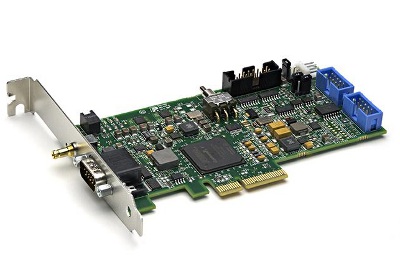 |
| June 13, 2017 | Volume 13 Issue 22 |
Designfax weekly eMagazine
Archives
Partners
Manufacturing Center
Product Spotlight
Modern Applications News
Metalworking Ideas For
Today's Job Shops
Tooling and Production
Strategies for large
metalworking plants
Engineer's Toolbox:
Qs to ask when specifying a frame grabber for machine vision applications
Over the last two decades, there has been a general trend toward the standardization of machine vision interfaces. Not long ago, engineers were required to purchase unique and expensive cables for every camera-to-frame grabber combination, or even camera-to-PC interface. In some cases, different cameras from the same manufacturer required an entirely different set of cables, resulting in costly upgrades and unsatisfied customers.

Affordable yet powerful, the BitFlow Aon-CXP frame grabber is optimized for use with the newest generation of smaller, cooler operating CXP single-link cameras popular in the Industrial Internet of Things (IIoT).
Standardization has changed that, making life easier for engineers and manufacturers alike. Camera Link became a universally accepted interface in 2001 and is still going strong. CoaXPress (2011), USB3 (2013), GigE Vision (2006), and Camera Link HS (2012) are also now universally accepted interfaces for machine vision solutions. Others such as Firewire have been in the market since the 1980s but are being replaced by newer interfaces. Thunderbolt, an Apple technology, is still on the periphery and not as widely developed or accepted into the market.
Nowhere has standardization been more keenly observed than in frame grabbers. Along with cameras and cables, frame grabbers are essential components in most high-end machine vision systems. Frame grabbers are essential for these high-end applications as the data rates exceed anything that can be provided by a non-frame grabber solution. They are also required when complex I/O signals are introduced into the vision system. Examples of these are quarature encoders, strobes, and triggers of various types.
With the introduction of high-speed communication links like Ethernet, Firewire, and USB, pundits forecasted the end of the frame grabber. After all, a smart digital video camera was capable of packaging information into packets for direct feed into a PC's communication ports, so there was no longer a need for a frame grabber, right?
Not so fast. For all their hype, Direct-to-PC standards are, at best, adequate for lower end applications. Cameras are evolving at a rapid pace and now produce megapixel images at extremely fast frame and line rates, far exceeding the 120-MB/s serial-interface limit. Vision engineers have found that frame grabbers offer advantages that continue to make them necessary, perhaps more now than ever before.
Specifying frame grabbers
The main component in a machine vision system that determines the frame grabber is the sensor. To find the right sensor, the customer must ask three questions about their intended machine vision solution:
- What do I need to image?
- How do I need to image it?
- When do I need to image it?
- Is there a large volume of data that needs to be acquired from the camera?
- Is there a high speed of data acquisition involved?
- What about timing?
- Are interrupts ok?
- Can the system deal with dropped or lost frames?
- Are there other components to consider such as encoders or strobes? Other I/O?
- Is it a multi-camera system?
- What is the maximum distance between the camera and the PC?
As important as these questions are, frame grabber costs can be as much of a factor as performance. For some, performance is the end-all and as such, they will specify the frame grabber that does precisely what is required no matter the price point. For others, price will dictate just how "exact" they want their system to be, or how much they can operate with certain limitations such as bandwidths and distances.
Supplier qualifications
Frame grabbers are no longer exclusively used in machine vision; they are now an essential component of dozens of industries. It is therefore important that the frame grabber manufacturer is involved in standards committees and other groups monitoring the evolution of this fast-changing technology.
It is equally critical that the manufacturer works closely with camera manufacturers, cable companies, and image-processing software developers to ensure that the customer will be able to integrate their choice of components with a specific frame grabber.
BitFlow has been in the business of frame grabbers since 1993. Over that time, BitFlow has advanced and adopted various machine vision interfaces to best serve the needs of the customer. The company's frame grabber interfaces now include Camera Link, CoaXPress, and Differential, and their solutions are coupled with powerful software and APIs that are compatible with popular image-processing software packages.
Source: BitFlow
Published June 2017
Rate this article
View our terms of use and privacy policy
